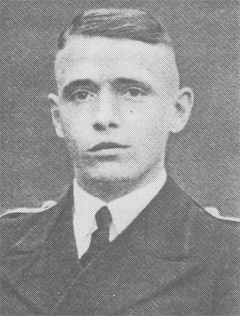3. Getting ready
The initial trials with the first available Type XXIs showed that the theoretical performance was almost met. The full submerged speed was slightly lower (17 instead of 18 knots) and could be maintained for a shorter time (60-80 minutes instead of 100). Overall, the performance was outstanding and offered much better prospects for attacking convoys and evading escorts than conventional U-boats.
At the silent submerged cruising speed the Type XXI had to schnorkel for only 3 hours a day to keep the batteries charged. This speed of 5 knots with a range of 365 miles meant that a U-boat would pass the dangerous waters between Norway and Iceland in 5 days schnorkeling shortly only 5 times. The radar-search receiver Tunis fitted to schnorkel and anti-radar rubber coating offered additional safety. Even when located, an alteration of speed and course would help to evade escorts or aircraft-dropped sonar buoys. When escaping at high speed, the Type XXI was almost as fast as most of the Allied escorts and bubbling of water rushing along the hull would make ASDIC location difficult. The potential area where a hunted Type XXI, escaping at the silent speed of 5 knots, would be forced to raise the schnorkel again was some 10-13 times greater than an area for conventional U-boat (escaping at 2 knots with a range of 100 miles). With the existing anti-submarine forces search abilities a chance for a kill was therefore greatly reduced.
The attack tactics was based on the following principles:
- location of a convoy by the listening device
- high-speed approach to the convoy
- penetration of the escort screen at silent speed and maximum depth
- getting underneath the convoy
- collecting firing data for the LUT looping torpedoes by echo-ranging
- firing spreads of torpedoes in order to cover the whole convoy
Special equipment was provided to facilitate the tactics, in particular a special echo-ranging plotting-table and an echo-ranging data converter which automatically calculated and set torpedo firing parameters. Due to the quick reload mechanism the Type XXI would need only one convoy encounter to fire all the torpedoes.
The preparation of the battle instructions for Electroboats was an interactive process with constant feedback and verification coming from the training units. The final battle instructions were written by experienced commanders: Erich Topp (for the Type XXI) and Carl Emmermann (for the Type XXIII). Others contributed though, among them Emil Klusmeier who later volunteered for a command in order to verify his ideas in practice and with U-2336 scored hits.
Although the first Type XXI was launched almost on time, the Electroboat building programme was eventually delayed by various means and the planned production figures had not been met. The following is the summary and status at the end of the war:
| Type XXI | Type XXIII | |
| Planned for delivery by 1/05/45 | 381 | 95 |
| Not produced because of the internal organization defects | 202 | 13 |
| Not produced because of Allied bombing on shipyards | 60 | 19 |
| Commissioned | 119 | 61 |
| Destroyed after commission
(trials, training, transit) |
20 | 2 |
| Training, fitting-out or on trials | 86 | 38 |
| Almost ready for combat | 12 | 15 |
| Fully ready for combat | 1 | 6 |
The failure to achieve the objectives was mainly caused by organization
troubles, faulty design and bad workmanship. It was particularly annoying,
when sections did not fit to each other because the specified tolerances
were exceeded. All these took place mainly in the first half of 1944 and
was fixed in the second half of the year. At that time, however, the Allies
realized the danger and started regular bombing raids, particularly on
shipyards and water transport installations (needed for transportation
of massive Type XXI sections).
Training for the new boats
Further delay in the project was caused by the extended training required for crews. The complexity of the design and new tactics meant that 6-7 months of training was required instead of usual 3-3.5 needed for conventional U-boats. Moreover, the training facilities were affected by the Allies actions, particularly the mining of the Bay of Danzig, the primary trial and training waters. The first mines were laid on 26/7 August 1944 by Bomber Command and continued regularly that eventually lead to the total abandoning of the area. The trials and tests were moved to the Bay of Luebeck which was much inferior, particularly because the area was within the range of Coastal Command.
The disruption of training caused that the Type XXI boats with practically one exception could not became fully operational in early 1945. Also, a number of boats that almost finished their training and awaited transfer to the Norwegian bases were lost in the dangerous Bay of Luebeck.
Operational Type XXI boats
The following Type XXI U-boats were almost ready for operations (on passage or in the operational bases, undergoing final preparations):
| Place | Flotilla | Boat | Commander |
| in transit | 11th Flotilla Bergen | U-2503 * | Oblt Raimund Tiesler |
| Bergen | 11th Flotilla Bergen | U-2506 | Kptlt Horst von Schroeter |
| Bergen | 5th Flotilla Kiel | U-3514 | Oblt Guenther Fritze |
| Stavanger | 4th Flotilla Sttetin | U-3035 | Oblt Ernst-August Gerke |
| Kristiansand | 31st Flotilla Hamburg | U-2529 | Kptlt Fritz Kalipke |
| Horten | 11th Flotilla Bergen | U-2502 | Kptlt Heinz Franke |
| Horten | 11th Flotilla Bergen | U-2513 | Korvkpt Erich Topp |
| Horten | 11th Flotilla Bergen | U-2518 | Kptlt Friedrich Weidner |
| Horten | 4th Flotilla Sttetin | U-3017 | Oblt Rudolf Lindschau |
| Horten | 4th Flotilla Sttetin | U-3041 | Kptlt Hans Hornkohl |
| Horten | 5th Flotilla Kiel | U-3515 | Oblt Fedor Kuscher |
| Wilhelmshaven | 11th Flotilla Bergen | U-3008 | Kptlt. Helmut Manseck |
* U-2503 was badly damaged by aircraft on 3rd May 1945 and later scuttled.
The following was the only one Type XXI U-boat fully ready for operations at the end of the war:
| Bergen | 11th Flotilla Bergen | U-2511 | Korvkpt Adalbert Schnee |
It is sometimes reported that U-3008 also
was ready for operations. She indeed sailed from Wilhelmshaven on 3rd May
1945, when the artillery bombardment was already heard. The U-boat may
probably been supposed to call in one of the Norwegian ports for final
provisioning before the patrol. In the North Sea, shortly after the order
to surrender which was issued on 4th May 1945, she encountered a convoy,
made a pass under it and sailed away undetected.
First war patrol by type XXI boat, the U-2511
U-2511, with a crack crew, sailed from Kiel on 16 March 1945 for the Norwegian base Horten in Norway. The war patrol was supposed to start on 26 March, but during deep dive test she sustained a periscope damage and was delayed. She sailed from Horten on the 18 April she was forced to put to Bergen on 21 April, due to diesel troubles. At last she sailed on 30 April 1945 with the orders to go to the Caribbean.
The first contact with the enemy was made on 1 May. On the following day U-2511 was detected by an escort group north of Scotland but easily got away with the increased underwater speed. She evaded other ships, too, as her objective was to get to the operation area first. Depth-charges were dropped but were helplessly wide. Soon after receiving the surrender message on 4 May 1945, U-2511 detected a Suffolk class cruiser, HMS Norfolk, with destroyer escort at a long range. She made a text-book approach, closing at high-speed first, then diving deep and passing the destroyer screen at silent-speed. Finally, Schnee had the cruiser in sights 500 meters away with a perfect attacking position inside the destroyer screen and undetected - impossible to miss. U-2511 did not fire but dived deep again, and still undetected returned to base, arriving at Bergen on 5 May 1945.
Operations by Type XXIII boats
The Type XXIII U-boats achieved operational readiness in early 1945 and had a chance to take part in the inshore campaign west of the Britain. They operated mainly from the Norwegian base of Christiansand. The following table gives the summary:
| U-boat | Commander | Operational area | Time of operation | Results/remarks |
| U-2324 | Oblt. Hans-Heinrich Hass | Firth of Forth | 29/01 - 24/02 | attack on 18/02
2 torpedo failures |
| U-2322 | Oblt. Fridtjof Heckel | Firth of Forth | 6/02 - 3/03 | sank the 1,317t Egholm on 25/02 |
| U-2321 | Oblt. Hans-Heinrich Barschkis | Firth of Forth | 12/03 - 13/04 | claimed a ship of 1,406t, no confirmation |
| U-2324 | Kptlt. Konstantin von Rappard | North Foreland | 3/04 - 4/05 | sank the 1,150t Monarch on 16/04 * |
| U-2322 | Oblt. Fridtjof Heckel | North Foreland | 5/04 - 5/05 | claimed a ship sunk on 29/04, no confirmation |
| U-2329 | Oblt. Heinrich Schlott | North Foreland | 12/04 - 26/04 | BdU reported damages the 7,209t Sverre Helmersen on 23/04 but this was probably a Seehund hit |
| U-2326 | Oblt. Karl Jobst | Firth of Forth | 19/04 - 28/04 | 2 torpedo failures, came back to reload |
| U-2336 | Kptlt. Emil Klusmeier | Firth of Forth | 1/05 - 14/05 | sank the 1,791 Sneland and 2,878 Avondale Park on 7/05 |
| U-2326 | Oblt. Karl Jobst | Firth of Forth | 3/05 - 14/05 | surrenderred in the UK |
* The sinking of Monarch has since been attributed to Seehund KU-5368.
Although a limited number of operations was carried out, it was proved that Type XXIII was an ideal U-boat for short operations in coastal waters. They were fast, easy to control, ready for continuous underwater operation, very difficult to locate, even when surfaced and could operate slightly longer than expected. None was lost although they were attacked.
The high underwater speed always allowed to escape. It also allowed to gain such a position against a convoy, it was possible to quickly attack 2 targets. Sometimes, however, the speed of the boat was underestimated which caused, that particularly the second torpedo was fired at too short ranges and failed to aim.
The only boat to score twice was U-2336 on 7th May which was also the last sinking by a U-boat in the war. Ironically, in this case the only significant technical weakness of Type XXIII was demonstrated - which was a faulty radio equipment. U-2336 would have not attacked, had she not missed the surrender signal on 4th May.
... the Elektro boats and the aftermath



